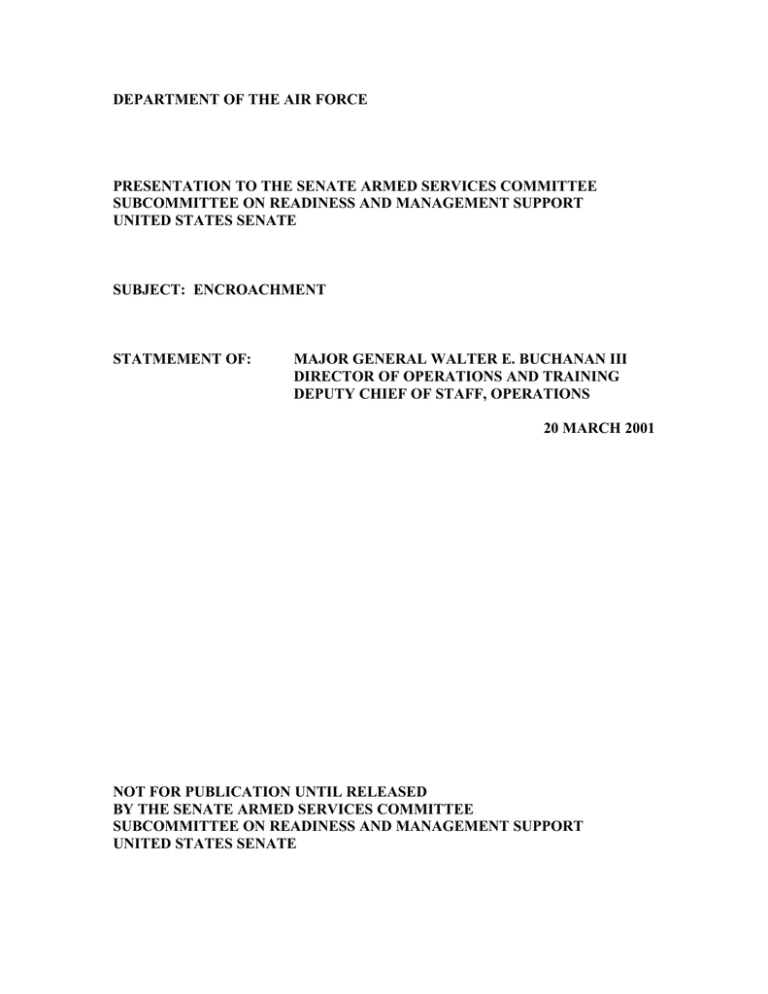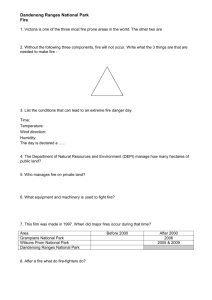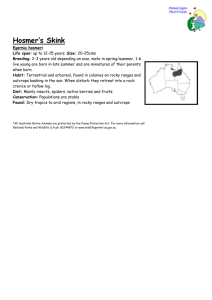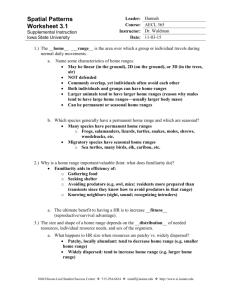DEPARTMENT OF THE AIR FORCE SUBCOMMITTEE ON READINESS AND MANAGEMENT SUPPORT
advertisement

DEPARTMENT OF THE AIR FORCE PRESENTATION TO THE SENATE ARMED SERVICES COMMITTEE SUBCOMMITTEE ON READINESS AND MANAGEMENT SUPPORT UNITED STATES SENATE SUBJECT: ENCROACHMENT STATMEMENT OF: MAJOR GENERAL WALTER E. BUCHANAN III DIRECTOR OF OPERATIONS AND TRAINING DEPUTY CHIEF OF STAFF, OPERATIONS 20 MARCH 2001 NOT FOR PUBLICATION UNTIL RELEASED BY THE SENATE ARMED SERVICES COMMITTEE SUBCOMMITTEE ON READINESS AND MANAGEMENT SUPPORT UNITED STATES SENATE Mr. Chairman and members of the Committee, thank you for the opportunity to speak to you about Air Force ranges and some of the challenges we face in the future to properly manage them. Maintaining continued access to our ranges and airspace is critical to readiness. These areas are national assets, which allow the Air Force to test new equipment, develop new tactics and train our aircrews. AF ranges also accommodate important civilian industry aeronautical testing, and provide for public use and natural and cultural resource protection. Background Current ranges are the successors of test and training ranges designed to support the Army Air Corps in World War II. Tactical fighters used decentralized “backyard” ranges (now called “primary training ranges”) to practice the release of live and practice bombs. Such ranges usually were located within a 150 nautical mile (NM) radius of their home bases. Strategic bombers trained on ranges and simulated deliveries using radar bomb scoring sites thousands of miles away. These ranges were customized to fulfill the training requirements of individual aircraft types and various missions. Large-scale exercises were conducted on training and test ranges, usually in the west, which could accommodate such tactics. Today, these ranges include an extensive electronic warfare array, an instrumentation system for tracking and recording aircraft activities, and multiple target concentrations. The Eglin Range, FL; Nevada Test and Training Range, NV; Barry M. Goldwater Range, AZ; and the Utah Test and Training Range, UT, are our largest ranges. 2 Present Ranges Today, management of Air Force (AF) ranges is the responsibility of several AF commands. Air Combat Command (ACC) is generally responsible for the majority of combat training that occurs on our ranges. Other commands that manage ranges predominately for training include the Air National Guard (ANG), Air Force Reserve Command (AFRC), Pacific Air Forces (PACAF), Air Education and Training Command (AETC), and United States Air Forces Europe (USAFE). Air Force Material Command (AFMC) is responsible for ranges primarily tailored toward test activity and Air Force Space Command is responsible for the management of the East and West Launch Ranges. Currently, all commands and service components share ranges. For example, the AF operates 17 ranges on US Army lands in the continental US (CONUS) and Alaska. Present Airspace The FAA manages the complex multi-use nature of the National Airspace System (NAS) to provide both safety and efficiency for civil and military users. Viewed in a two-dimensional perspective, military Special Use Airspace (SUA) appears to cover a large portion of the CONUS. Adding the third dimension (depth) shows that civilian air traffic uses the airspace above SUA even when it is active. But to gain a true perspective of the AF’s use of the National Airspace System (NAS), the fourth dimension (time) must be considered. In other words, as our force structure has decreased, the time we use the NAS has also decreased. Ranges and Airspace in the Future Consolidation of units after base closures, more capable aircraft systems, long range precision weapons such as JDAM, JSOW, and AMRAAM and constantly changing 3 tactics will continue to obligate the AF to modify and consolidate our ranges and SUA to allow our aircrews to be the most proficient possible. The training range of the future will still exist in three basic formats— smaller primary training ranges that provide a chance for local units to hone their skills on a dayto-day basis , intermediate size ranges such as the Air National Guard’s Combat Readiness Training Centers which allow for more complex skill training in an increasingly instrumented environment, and large ranges which provide a complex environment of threats, targets, and instrumentation needed for large force exercises. Ranges will continue to be needed for test purposes providing the large air and land areas necessary for advanced and live weapons evaluations. Test and space ranges also accommodate a substantial number of civilian aviation and space activities. Large training ranges, dedicated to large force exercises will routinely include three types of participants—real operations on the scene, operations from participants linked by simulators, and simulated players. Primary Training Ranges will continue to serve nearby flying organizations. Some long-range weapons delivery tactics will be simulated. However, the Primary Training Range will still be important and will require modifications for basic weapons and electronic warfare training in the future. Range Management in the Air Force In the coming years, our ability to modify ranges and airspace will be critical to maintaining AF readiness. However, the legal and procedural requirements are more and more complicated and time consuming and military needs can change quickly. In 1994, the Air Force was in the middle of an important range project that eventually failed and an equally important airspace project that was ultimately successful. Gen. Ralston, the 4 AF Deputy Chief of Staff for Plans and Operations at the time, reorganized his staff to consolidate operational range and airspace management policy and provide operational leadership in this important area. Although ranges and airspace are still managed by either individual units or the major commands, Gen. Ralston set the vision for range and airspace management that we still follow today. Our goal is to meet the military need while addressing and resolving, to the extent possible, public concerns and federal, tribal, state, and other agency issues. We have adopted a spirit and practice of flexibility, and a willingness to adapt when we can without compromising our operations. We also realize the importance of establishing and maintaining permanent relationships with stakeholders. Most of those stakeholders are very supportive of the AF and our mission. Sustainable access to ranges benefits many people. Our ranges contain significant cultural and natural areas, are used for grazing and agriculture, and allow hunting or other forms of outdoor recreation. Challenges to Sustainable Ranges and Airspace In this session, I intend to focus on five areas that stress our ability to maintain sustainable access to ranges and airspace. They are unexploded ordnance, air quality, noise, the NAS Redesign, and endangered species. These areas are generally referred to as encroachment issues. Encroachment on ranges and airspace is a serious and growing challenge to the Air Force, as well as the other services. Encroachment issues are complex and involve multiple federal, state, tribal and local agencies, as well as Congress and the public. Meeting the challenges to readiness posed by these issues will be key to meeting the military need and abiding by the myriad of laws regulating ranges and airspace. 5 Unexploded Ordnance (UXO) UXO and the disposal of residue material (primarily scrap metal) on air to ground ranges is one area where we have taken a hard look at our practices and policies recently. UXO and range residue (used targets, inert ordnance, etc.) physically occupy only a very small part of any air to ground range, but its presence is an increasingly expensive problem. The costs associated with clearing closed ranges have led us to the conclusion that we need to plan and manage for the entire life-cycle of a range. The AF first started clearing ordnance from active ranges in the late 1940’s. Active range clearance not only provides for safe target area operations, but also provides airfield-recovery training for our Explosive Ordnance Disposal specialists. AF policy requires that active air to ground ranges be cleared on a quarterly, annual, and 5-year basis at varying distances from each target. We have reviewed our practices and found that we could make some changes that would still allow us to meet our military need and lessen the impacts and costs in the future. This, combined with our current scheduled UXO and residue removal program, will ensure long-term range sustainability and the safety of personnel on the range. Our ultimate goal is to manage our ranges effectively and efficiently throughout the life-cycle process that allows for sustainable operations, safe and effective UXO and residue treatment, and long term environmental stewardship. These policies are not without costs. One of our commands, Air Combat Command, is currently undertaking a project to remove the legacy of residue that has accumulated on some of our ranges. In FY00, the AF dedicated $4.8M to this effort, removing residue at the rate of one million pounds per month. At current funding levels, it is estimated it will take approximately four years to remove known accumulated residue from ACC’s 6 primary training ranges alone. Remediating closed ranges and clearing active ranges will need to be a long and incremental process to be affordable under today’s budgets. The same active range operations and maintenance budgets that fund targets and electronic warfare operations for our aircrews fund UXO and range residue removal. Anything more aggressive than a long-term program will significantly strain present readiness accounts. Air Quality Many of our largest and most important installations are located in areas that are experiencing rapid growth and the attendant pressures resulting from air quality standards. A number of our bases are currently located in “nonattainment” areas, and more bases are in areas that surely are destined to become nonattainment areas. Air quality pressures generally affect operations at our installations more than ranges, and they potentially limit our basing options to support force realignment and weapon system beddowns. If the beddown action is found not to conform to the state implementation plan for Clean Air Compliance, the Air Force must either obtain air quality credits, or reduce other emissions at the base to counter balance the impact. Otherwise, the proposed action can not take place. We are working very hard to lower our emissions at our installations. We are working to ensure that environmental, safety, and health considerations-including air quality--are integral to requirements definition and the acquisition process. We are working with state regulators and local communities to ensure we have the flexibility to base aircraft at our installations which have huge investments in infrastructure not only on the installation itself, but also in the ranges used by installation aircraft. 7 Noise Noise from military aircraft is one of the most obvious byproducts of military readiness and has long been a dilemma at our bases. Additionally, many people are increasingly concerned with noise along many of our low-level flying routes, in our military operating areas, and on our ranges. Today, noise is the AF’s number one concern when we try to modify or establish new airspace. We often hear the “not in my backyard” philosophy. Some people say they want a strong national defense as long as the AF flies “somewhere else.” However, if you look at a map of the US, “somewhere else” doesn’t exist. In fact, “somewhere else” is always “right here” for someone else. In some cases, we can accommodate public noise concerns with no loss to the effectiveness of our training. When apprised of a noise sensitive area, we routinely chart it and avoid it if possible. In a few instances, we have made allowances for short periods in National Park recreation areas when the park experiences its maximum number of visitors. When we cannot deconflict schedules, we try to communicate to users and managers alike to let them know what we are doing; when we are flying and why. We have found that altering their expectations and increasing their knowledge of what is going on can reduce a person’s negative reaction to noise. This program will coordinate policy, plans, and funding for noise effects, maintain noise models, and oversee R&D efforts. It will also include efforts to ensure that environmental, safety, and health considerations--including noise--are integral to requirements definition and the acquisition process. 8 The services have formulated a plan that will eventually lead to a unified DoD noise program to address the full range of noise issues not only from aircraft, but also from other military operations, testing and training. National Airspace Redesign Despite a decrease in military force structure and total flying hours, the DoD has a continuing requirement for airspace to train in. At the same time, fueled by deregulation and relatively affordable fares, the civil airline industry has grown steadily. The projected growth rate of the civilian airline industry is expected to continue at a 6% annual increase for the foreseeable future. In 1998, the Federal Aviation Agency (FAA) initiated the National Airspace Redesign program. This program has been commonly called “Free Flight.” The goals of the redesign are to maintain system safety, decrease system delay, increase system flexibility, increase predictability, and increase user access. A part of “user access” is DoD Special Use Airspace (SUA), which is necessary to conduct critical testing of equipment and training of aircrews. In the future, the key to the successful establishment, modification and use of SUA will require the application of four following parameters: Volume - enough to accomplish operational, test or training objectives Proximity - distance to operating airfields Time - available when operations, test, or training required Attributes - ability to accomplish specific air/land/sea events The first three are self-explanatory. The term “attributes” refers to the quality that differentiates one piece of airspace from another. For instance, there might be a 9 range under the airspace, or mountainous terrain needed for a particular test or instrumentation needed for training. The key to maintaining our access to SUA is to work closely with the FAA. The senior members of the DoD Policy Board on Federal Aviation along with the Department of Transportation/FAA are currently determining a plan for effective joint FAA-DoD interaction. We will have to be able to predict and articulate our requirements. In order to move toward more real-time use, we will have to work with the FAA to focus on the technology necessary to make real-time work. And finally, we will have to take advantage of the natural flexibility of air operations to work creative solutions to difficult issues. Endangered Species Currently, 79 federally listed threatened and endangered species are found on approximately nine million acres of AF lands and waters. They include various species of antelope, bats, mice, reptiles, amphibians, and plants. In some cases, our installations and ranges are the only large, undeveloped and relatively undisturbed areas remaining in growing urban areas. This often leaves AF lands as the last refuge in the region that can support endangered species. Biological Opinions resulting from required Endangered Species Act assessments have resulted in range and airspace restrictions mainly associated with aircraft noise and munitions use. We operate under altitude restrictions due to noise and its possible effects on endangered species in Arizona and New Mexico. The Barry M. Goldwater Air Force Range in Arizona is home to the last 100 hundred or so Sonoran Pronghorn Antelope in the United States. The DoD flies about 70,000 10 sorties there each year. Seven different target areas are surveyed daily before we fly any sorties. If there are antelope present, we do not drop or strafe on that target that day. The potential designation of range areas as critical habitat could seriously limit our ability to modify missions on our lands. We need to work with other agencies to ensure that habitat constraints do not restrict our operations. For instance, in the Sonoran Desert, we are participating in a DoD/Department of Interior sponsored ecoregional study. This study, conducted by the Nature Conservancy and the Sonoran Institute, with the cooperation of the Mexican State of Sonora, has characterized the resources on over 55 million acres in the US and Mexico. This broad view by over 100 academic, agency, tribal and public Sonoran Desert experts will help federal agencies and local governments to set their resource planning within a larger ecoregional context. The US Marine Corps and the AF are using the study as a starting point for the Integrated Natural Resource Management plan for the Goldwater Range and Pima County, Arizona has incorporated the study into their overall planning effort. Marine environmental protection regulations also have the potential to impact Air Force operations. The Air Armament Center at Eglin AFB, FL uses live munitions over the Gulf of Mexico for a wide variety of live ordnance test and training and has obtained permits from the U.S. Fish and Wildlife Service (FWS) to allow them to carry out their mission. For example, gulf sturgeon in the area are electronically tagged. FWS employees track the sturgeon to ensure they are not in an area where live ordnance is being detonated. The key to addressing endangered species is adequate science and good communication. The AF will continue to monitor activities outside our fence-line and 11 continue to engage with local communities. We have found that where we have good relationships with regulators, we have been able to develop cooperative strategies that allow the AF to accomplish its mission while at the same time providing the necessary stewardship of this nation’s natural resources. Summary The Air Force manages approximately 9 million acres of bases and ranges. When many of these installations were established they were in rural, sparsely populated areas like the deserts of the southwest. These areas are seeing double digit increases in population growth. In order to ensure that the rapid pace of urban growth in some areas does not endanger our existing capital investment in base infrastructure, as well as our ability to access test and training areas, we will need to work closely with local governments and other interested parties to safeguard our capabilities to operate effectively as an AF. We not only need land and airspace, but we also rely heavily on critical parts of the electronic spectrum to carry out our missions. We must also ensure we can continue developing new electronic countermeasures and counter-countermeasures systems and capabilities as well as exercise existing systems as closely as possible to how we would employ them in conflict. To date, the impacts of encroachment have resulted in minor impacts to our operations, with work-arounds being implemented to avoid significant readiness impacts. However, we expect to encounter increasing challenges not only with our current level of operations, but also with beddowns of new weapon systems or realignments. 12 Maintaining continued access to AF ranges and airspace is vital to sustaining mission readiness. The AF recognizes the need to balance its test, training, and readiness requirements with responsible stewardship. There will be challenges in the future. Effective communication is the key. The partnerships we have with our sister services, civilian government agencies, and other stakeholders are essential. Together, we can meet these challenges head-on and sustain our readiness into the 21st century. We continue to look to our ranges and airspace to provide the AF the operational flexibility, efficiency, and realism necessary to continuously enhance readiness while allowing commanders to minimize, to the extent possible, the impacts of their mission on the community, the environment, and the National Airspace System. 13






